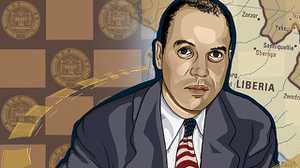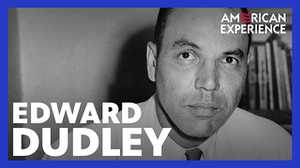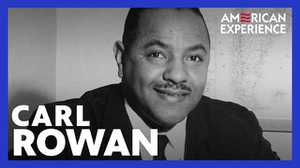How a Black Journalist-Turned-Ambassador Changed the Game in Both Media and Diplomacy
The Washington Post’s first Black female reporter remembers one of her heroes, Carl Rowan.

When I came to Washington as the first Black woman reporter at The Washington Post in 1961, Carl Rowan was already one of my heroes. I knew he had enormous talent, and he had displayed courage and brilliance in covering some of the most important national and international issues of the day.
Our paths crossed socially and professionally as we wrote about some of the same issues. While Rowan and I both worked as journalists in Washington, his focus was on national and international affairs, and mine was primarily local. Still, he was an inspiration to me throughout my career.
I first met Rowan in 1957 while he was covering “The Little Rock Nine” — the Black students selected to integrate Central High School in Little Rock, Arkansas. I was a 20-year-old reporter at the Tri-State Defender, a Black newspaper in Memphis, Tennessee. My editor, L. Alex Wilson, had already told me that he didn’t want to send me to Little Rock, saying it was too dangerous because I was a rookie and a “girl.” After I saw television coverage of Wilson being savagely beaten by an angry white mob of Little Rock parents, I went there anyway to spend a few days reporting.
I knew that Rowan had been one of the few reporters employed by the white press writing about race relations in the South long before others followed suit. For years, it had been the exclusive story of the Black press, who often had to sneak into towns in the evening, their typewriters wrapped in clothes, as white sheriffs and others often were all too eager to beat or even kill them.
Still, I was shocked by what happened just five years later in 1962 when James Meredith enrolled at the University of Mississippi after being turned away from the campus four times. I was covering local news at the Post, bringing the number of black reporters at the paper to three and joining the handful of black reporters being hired by white dailies. My editors told me that they wanted to send me to Mississippi to cover the reaction of blacks in Oxford and other parts of the state to Meredith's integration of the university. I was pleased to get the assignment, although understandably nervous.
My first challenge, like that of other Black reporters traveling in the South, was finding lodging. Our only option was to try to find a bed or couch with a Black family or business. In my case, I stayed at a Black funeral home where I literally slept with the dead. After a long legal battle, Meredith was finally brought into one of the dorms. Anarchy ensued, and two people were killed, including a French journalist. I realized then those white segregationists hated all northern journalists, not just the Black ones.
Reporting for the white newspaper The Minneapolis Tribune, Rowan had traveled extensively through the South, beginning in the 1950s, writing award-winning stories on racial strife. He had also written impactful series on India, Southeast Asia and Africa, and he had covered the United Nations as major international crises were being debated. As a result, he was uniquely qualified when he was tapped by the Kennedy and Johnson administrations to serve as a spokesperson and diplomat for the State Department and the United States Information Agency.
Rowan grew up in McMinnville, Tennessee, where his father struggled to find regular work and living conditions were harsh. As Rowan’s son Jeffrey said in an interview, “He grew up in as poor a circumstance as you could ever imagine. He used to talk about how he learned to eat every kind of rabbit…because they didn’t have access to other meat. They would go out in the woods and hunt rabbit.”
Rowan was fortunate to have a teacher in high school who inspired him to read widely and think about his future. In his book Breaking Barriers: A Memoir, Rowan describes how the teacher, Bessie Taylor Gwynn, whom he called “Miss Bessie,” told him: “If you don’t read, you can’t write, and if you can’t write, you can stop dreaming.”
After high school, Rowan enrolled at Tennessee State after first working at the state tuberculosis hospital in Nashville until he had enough money to pay for one quarter. He thought that he was going to have to drop out for lack of funds. Somehow, he found a $20 bill on the ground, enough to cover the next quarter, and scraped together money to continue after that.

Several quarters later, his life took an unexpected turn. Rowan was summoned to the dean’s office. To the surprise of the college, the Navy had asked the school (along with other Black colleges) to nominate a student to take the examination for admission to the Navy V-12 naval officer training program, and he was Tennessee State’s candidate. Rowan passed the exam and enrolled at Washburn University in Topeka, Kansas, in the fall of 1943, the only Black student among the 335 young men. After completing his training at Oberlin College in Ohio, Rowan became a naval officer at age 19, serving as a communications officer on several ships until he was discharged in 1946.
After the war, Rowan was dismayed by the lack of respect for Black GIs, even though his father had told him that when he and other Black soldiers returned home after WWI, “White folks got real mean.” In one particularly egregious case at the close of WWII, Isaac Woodward, a Black Army sergeant, was taken off a bus in South Carolina while traveling home to North Carolina. He was brutally beaten by the local sheriff to the point that both of his retinas were damaged, and he was blinded. The sheriff was later tried but found not guilty. The verdict strengthened Rowan’s resolve to become a journalist. “I believed that I could change things,” he recalled in the memoir.
Rowan returned to Oberlin to finish his college degree, then applied to graduate journalism programs. Before enrolling in the University of Minnesota, he spent the summer and fall of 1947 reporting for the Baltimore Afro-American, traveling “from one racial hotspot to another.”
After earning his master’s degree in 1948, Rowan applied for a job and was later hired at the Minneapolis Tribune. Two years later, his career really took off after he had “a big idea one day.” While browsing newspapers in the paper’s library, Rowan said that he “saw story after story of racial violence in the south…and then it hit me.”
He recalled a conversation he had had during naval officer training with Noah Brannon, a young white religion student from Brownsville, Texas. One evening, Brannon had asked, “Carl, where is that overpowering odor that they told me all Negroes have?” That was a common stereotype of African Americans, but the comment led to a discussion in which Rowan shared examples of the realities of life for Blacks in the South. Afterward, Brannon urged him to write about those experiences one day, saying, “If you’re a white Southern person, you see these things and you don’t. You’re taught not to care.”
So, with the conversation with Brannon in mind, Rowan wrote a memo to his editors, suggesting that they allow him to write about “what it meant to be a Negro in the post-war South.” To his surprise, they immediately agreed.
At the same time, Rowan had been mulling what it meant to be a Black reporter on a white newspaper. “In 1950, no more than five Blacks could claim to be general assignment reporters, and few were writing anything serious… ‘What is your responsibility?’ I asked myself… as I wrestled with my precondition that I not become ‘just a Negro reporter.’ I told myself, ‘You can still be ‘just a reporter’ and help change America.’”

The subsequent 18-part series, “How Far from Slavery?” was published in January and February 1951. Rowan had traveled 6,000 miles in six weeks, going to 13 states and Washington, D.C. Describing life under Jim Crow, he wrote: “It is a life of doubt, of uncertainty, as to what the reception will be even from one building to another…Because few statutes are favorable to the Negro, the white man’s mood and spoken word becomes law.”
Time magazine took note of the work, describing the articles as “a perceptive, well-written series on segregation and prejudice in the South as only a Negro could know.”
Two years later, the Supreme Court was preparing to consider the school desegregation lawsuits that formed the basis of Brown v. The Board of Education. Rowan traveled to the five places represented in the case. He titled the series “Jim’s Crow Last Stand.” The series won numerous awards, including the Sigma Delta Chi (the Society of Professional Journalists) award for best general reporting. Rowan was “jubilant” when the Supreme Court ruled that state-imposed racial segregation in public schools was illegal, writing (naively, he later admitted) that Jim Crow is “a dead bird.”
Then came the call that added another dimension to Rowan’s journalism career. The State Department gave him a grant to tour India for three months and lecture on the role of a free press in a free society. Rowan, ever enterprising, wrote a series afterward for his paper titled “This Is India.” After his India tour, he was offered a second grant to spend three more months giving similar lectures throughout Southeast Asia.

That time spent traveling and reporting abroad turned Rowan into the paper’s de facto foreign affairs writer. The following year, he covered the Bandung Conference, a significant international conference in Indonesia of Asian and African states. While there, he managed to arrange a sit-down interview with Chou En-lai, the premier of Communist China. He also wrote a series on Canada (“Our Unknown Neighbors”), as well as another one in which he profiled some of the leaders and countries in Africa that he felt Americans should know about.
Rowan won the Sigma Delta Chi medallion for three years in a row, two of them for his coverage of India and Southeast Asia. In his autobiography, Rowan wrote: “I left [the awards ceremony in] Chicago that night, hoping fervently that the stories of my success would cause publishers, editors, station managers and news directors to conclude that they needed some of the talent that was going to waste in Black America.”
Rowan decided that it was time to return to the South. At his suggestion, he was accompanied by a white colleague, Richard Kleeman. The plan was to write another series “about the orgy of racism that is building up” over the Supreme Court decision on school desegregation.
As they were preparing for their trip, they learned of Rosa Parks’s arrest on December 1, 1955. The pair immediately flew to Montgomery, where Rowan attended a boycott strategy session at which both the Rev. Martin Luther King, Jr. and the Rev. Ralph Abernathy were present. Rowan, who saved his notes from that meeting, recalled King saying, “The Negro church will play a great role in the coming of integration. As soon as we can inspire the ordinary Negro minister to take a stand for integration, that will inspire Negro churchgoers to act.”
Later, back in Minneapolis, as the first story in their 16-part series, “Dixie Divided,” was about to be published, they got a call from the paper. The Associated Press was reporting that the Montgomery bus boycott was over after 49 days as three Negro ministers had agreed to end it. Did they want to change or drop their first story?
It took Rowan several hours that evening to reach King, who was startled to hear of “the phony announcement.” He had not agreed to it, and the three ministers did not represent the leaders of the boycott. If Black people thought it was over, however, they might go back to riding the buses and the boycott would effectively end. King rallied volunteers to go into the streets, shouting, “The boycott isn’t over.” Later, in his book Stride to Freedom, King credited Rowan with “saving the boycott.” The boycott continued for 11 more months.
While Rowan and Kleeman were still writing the series, the Tribune dispatched Rowan to the United Nations to report on two unfolding urgent international incidents: the Suez Canal crisis in Egypt and the Soviet invasion of Hungary. Reflecting on the situation in Hungary, Rowan questioned in his mind how his fellow Americans could condemn what the Soviet Union was doing while tolerating what was happening in the South.
As the 1950s came to a close, Rowan’s reputation and journalistic reach had grown. He had authored three books, South of Freedom, (based on the “How Far from Slavery’ series), The Pitiful and the Proud (on India, Southeast Asia and the Bandung conference) and Go South to Sorrow (on the progress of school desegregation efforts). Rowan, who still remembered being desperately poor while growing up, also augmented his newspaper salary by writing regularly for The Saturday Evening Post, Look, Reader’s Digest and Ebony, among other publications, and by accepting the frequent speaking invitations that came his way.
He continued to be the reporter that the Tribune turned to for big assignments. At the suggestion of his editor, and with the help of Sen. Hubert Humphrey and Eleanor Roosevelt, Rowan secured an interview in 1959 with former president Harry Truman, who was turning 75. Never shirking from hard questions, Rowan asked Truman, “Why would someone from Jim Crow Missouri be so concerned about civil rights?” Truman replied that he fought for civil rights laws “because it was right.”
Rowan also was picked by his editors to conduct probing interviews with both Richard Nixon and John Kennedy during the 1960 presidential campaign. After Kennedy won, thanks to the support he got from Black voters, Rowan took note of some of the Blacks that Kennedy was recruiting to work in his administration out of “journalistic and intellectual curiosity,” thinking to himself that he could never be a politician.

But on January 1, 1961, Rowan got a call from Louis E. Martin, a pioneering Black journalist who had worked on Kennedy’s campaign. Martin said that Kennedy wanted Rowan to join the State Department as part of his administration. After weighing the offer for a month, he resigned from the Tribune.
According to Jeffrey Rowan, when his father asked Kennedy why he offered him a job, Kennedy replied that some influential African Americans had endorsed Nixon and that he was expecting Rowan to write a “hatchet job” about Kennedy. Instead, Kennedy liked what Rowan wrote, telling his staff, “Find this guy and see if he wants to join my State Department.”
Under Kennedy, Rowan first served as the deputy assistant secretary of state and then as the U.S. Ambassador to Finland. After Lyndon Johnson became president, he asked Rowan to return to Washington to head the United States Information Agency. Rowan, who attended Johnson’s cabinet meetings, as well as those of the National Security Council, watched as Johnson managed to push through groundbreaking civil rights legislation.
But increasingly, Johnson’s main focus and preoccupation was the Vietnam War. Even though the president kept insisting he didn’t want “a wider war,” Rowan watched in alarm as the resources and number of troops devoted to the war kept increasing. Johnson also was furious with the Rev. Martin Luther King, Jr. because of his opposition to the war. In the end, Johnson’s paranoia and secrecy regarding the war prompted Rowan to resign in July 1965.

He signed a lucrative deal to become a syndicated columnist, and more than 100 daily newspapers quickly agreed to carry his column, although many Southern newspapers did not. Rowan also was a panelist on a weekly television talk show on which top news events were discussed, and he resumed writing books, including one on Supreme Court Justice Thurgood Marshall.
As a regular reader of Rowan’s column, I admired his intellect and the issues he addressed. So in 1979, inspired by Rowan and William Raspberry, my Post colleague who had a column, I told Ben Bradlee, executive editor of the Post, that I wanted to become a columnist. I began doing so a few months later and continued to write my Post column twice a week until 1997. Rowan helped me to see that a larger role was possible, and I was up for the challenge.
Rowan, perhaps recalling his own struggles to pay for college tuition, also founded a program in 1987 to award college scholarships to top African American students in the Washington, D.C. area. Under that program, called Project Excellence, 1,150 students received scholarships totaling $26 million from 1987 to 2000.
I will always remember Rowan, who died in 2000, as a true trailblazer. An old African American proverb says: “Each one, teach one.” Rowan’s legacy includes his ground-breaking body of work, the many African American journalists like me who have worked to make the media reflect the diversity of America and the many students who were able to get a college education, thanks to Project Excellence. We should all endeavor to have such an impact.

Dorothy Butler Gilliam is a former reporter, editor, columnist, author and educator, who made history as the first African American female journalist hired by The Washington Post. Gilliam began her journalism career in 1957, as a reporter for The Memphis Tri-State Defender, a black weekly, where she covered the integration of Little Rock Central High school by the Little Rock Nine. She has been a reporter of, and advocate for, civil rights and social change ever since.
Research Assistance for this piece provided by Jeanne Fox Alston








